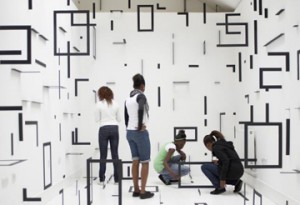Over the past ten years, an interesting and forward-looking trend among contemporary art galleries in the United Kingdom has been the aim to secure a legacy beyond the general functions that a gallery has. Historically, building and maintaining a roster of interesting artists befitting the remit of the gallery itself, as well as being able to exhibit innovative and groundbreaking work, would be the first port of call to generate sales and traveling exhibitions – the bread and butter required to shore up sustainability. We here in the UK are lucky, insofar as we have a cultural sector that has strong funding support, channeled via the appropriate organizations, from central government. Public galleries at least are beginning to bear the fruit of long-term planning instigated to explore what it means to be a gallery in the 21st century.
Since the final years of the 20th century, the scale of capital built across the UK’s contemporary art galleries has escalated with large-scale, concept-specific projects constructed across the country. InIVA, the Institute for International Visual Arts, opened in London in 1994 with a remit for the development, exhibition, and conservation to address the imbalance in the representation of culturally diverse artists, writers, and curators. A member of the Liverpool Arts Regeneration Consortium, FACT (Foundation for Art and Creative Technology) is one of the UK’s leading film, video, and new media exhibition, education, and research projects. Also on this list are the expanded Whitechapel Gallery; The Public, in Walsall; Nottingham Contemporary; Newlyn Art Gallery & The Exchange and, opening this Friday June 25, the newly expanded and refurbished South London Gallery.
One of the leading lights in the small-scale contemporary art gallery scene in London (a not-insignificant sector that includes Matt’s Gallery, Chisenhale Gallery, The Showroom Gallery, and Camden Arts Centre), South London Gallery has undergone a £2 million extension by the young architectural firm 6a Architects in order to cement the gallery’s position as one of the few of its kind to combine a consistently high-quality exhibition program with strong management and able direction.
Based on the Kunsthalle model, the primary functions of a contemporary art gallery have merged into what could be described as a contemporary art museum. Embedding the gallery within the fabric of the local community, drawing and engaging more with that core primary audience, are steps taken to ensure that the gallery is more than just a home for a rolling programme of exhibition so that it functions as a local public building for the development of culture.
As the site of the former estate of Portland House, South London Gallery has always been set back from the street. I don’t need to tell you about the difficulties that contemporary art has with engaging a traditionally unengaged audience, but these institutions have been taking simple measures to invite audiences to develop new relationships of engagement, among them the café, the gift shop, artist residencies, education centers, libraries, archives, reading rooms, permanent collections. Refurbishment and expansion is about more than just having more space for a curator and artist to play with; rather, artspaces need to encourage people to come in, have a coffee, browse a few books in the bookstore, use a computer, or take a class. One of the problems highlighted during the local public consultation in the planning and development of the Whitechapel Gallery extension was that, from street level, it seemed as though there was little movement inside. For all intents and purposes, it seemed permanently closed. To remedy that, the decision was made to open a restaurant on the grounds that can be seen, and directly entered, from the street.
None of this detracts from the artistic endeavour of the institution. Director of South London Gallery, Margot Heller, has done a remarkable job in attracting high-profile international artists during the nine years of her post, including Serpentine Gallery staple Christian Boltanski, Franko B, Superflex, Alfredo Jaar, and Mark Dion. Furthermore, the gallery will now be able to take advantage of the 6000+ works in its permanent collection, holding items from artists such as Mark Wallinger, Rut Blees Luxemburg, Zarina Bhimji, Antony Gormley, Donald Rodney, and Anish Kapoor. In the fifteen months since Whitechapel Gallery re-opened, director Iwona Blazwick has been able to expand the gallery’s programme to include 2009’s startlingly high-quality Max Mara Art Prize for Women and showcase the world-class work driven by writer-in-residence Maria Fusco (Director of Art Writing MBA, Goldsmiths) at the inaugural Festival of Art Writing 2009, and Volatile Dispersal, an unique event comparable only to some of the satellite shows of Printed Matter’s annual New York Artist’s Book Fair. All this takes place, of course, in addition to a rolling programme of exhibitions, set to a backdrop of Goshka Macuga’s eighteen-month installation surrounding the tapestry of Picasso’s Guernica.
The six constituent colleges that comprise University of the Arts London year-on-year have the largest number of arts graduates in Europe. Stabilizing the foundations of the economy in which they will work is paramount in keeping London near the forefront of international artistic development. As it appeared that the UK would be exiting a recession, only to face severe funding cuts, the fact that Heller, at a small-scale gallery, can raise both the funds and the issue that this kind of development is not just required but a necessity, is a proud day for contemporary British art. There are other, surprising names, that feel they and their organizations are being left behind. Surprises lie around the corner.




